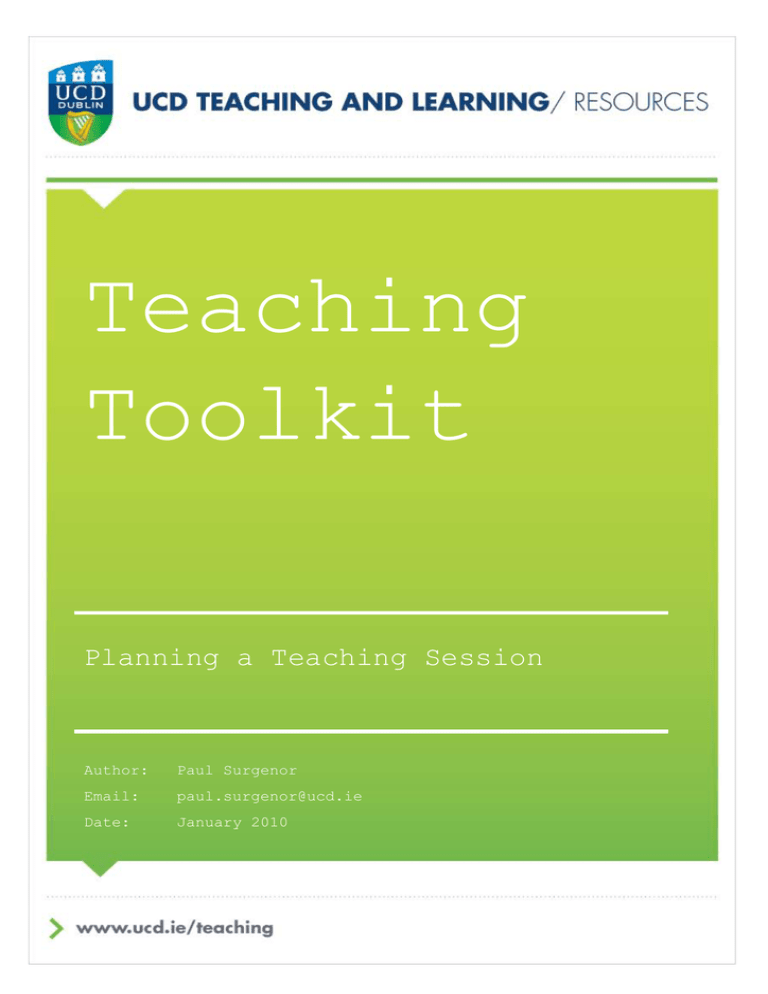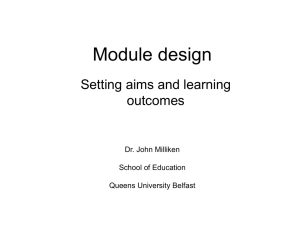Planning a Teaching Session
advertisement

Teaching Toolkit Planning a Teaching Session Author: Paul Surgenor Email: paul.surgenor@ucd.ie Date: January 2010 Planning a Teaching Sessions In an outcomes-based curriculum, classes, modules, and programmes are designed based on the end goal, the skills and knowledge the students should be able to achieve as a result of the class, module, or programme. Despite inconsistencies in the literature, it has been recommended that the term ‘outcomes’ is used to describe what a student should be able to do at the end of a lesson, module or course. The term competencies (sometimes referred to by the synonymous term “competences”) is best used as defined by European Union’s Tuning Project, namely, as what students have when they have successfully achieved the stated outcomes of a programme of learning (Deusto University 2006). The main theoretical underpinning of the outcomes-based curriculum is provided by Biggs (2003). He calls the model constructive alignment which can be defined as: …coherence between assessment, teaching strategies and intended learning outcomes in an educational programme (McMahon & Thakore, 2006, p10) Constructive alignment, generally attributed to Biggs (2003, 1999), requires alignment between the three key areas of the curriculum, namely, the intended learning outcomes, what the student does in order to learn, how the student is assessed (see Figure 1). Teaching & Learning Activities Intended Learning Outcomes of Curriculum Assessment Regime The outcomes are formulated first Once an appropriate assessment regime has been designed, activities are organised that will teach the student how to meet the assessment criteria (and, hence, the outcomes) From these the assessment criteria are developed What the teacher does and what the students do are specifically and openly aimed at achieving the outcomes by meeting the assessment criteria. This takes advantage of the known tendency of students to learn what they think will be assessed – and is called backwash (Biggs 2003). Figure 1: A Basic Model of an Aligned Curriculum Biggs suggests that teaching and learning activities are designed second and the assessment regime third. An example of constructive alignment in a curriculum is presented in Figure 2. Title of Module: Evaluating and Reflecting on your Teaching. Outcomes On completion of this module you should be able to: Monitor, evaluate and reflect on your teaching and the learning of your students Use a range of methods to gather student feedback. Contribute to the debate on the links between research and teaching. Assessment Critically reflective written report containing the following: Evidence of having completed the prescribed mentoring – observation cycle A reflective statement of personal and professional gains made from the peer observation process Evidence of having received and responded to student feedback A reflective statement of what has been achieved as a result of gathering feedback from students. Formatively assessed by tutor comments in forum. (In preparation for formal assessment of this outcome in a future module.) Teaching / Learning Activities Introductory Group Tutorial – Revision of critical reflection theory (from previous modules). Seminar: Introduction to Peer Observation and the use of a Learning Contract. Project: be observed teaching and take part in a reflective discussion with the observer. Workshop: Methods of Gathering Student Feedback Project: Collect, analyze and respond to feedback from students undertaking a module or course. On line forum. Figure 2: An Example of Constructive Alignment in a Curriculum If this sequence is adopted, it is important that activities are designed which enable students to learn how to demonstrate achievement at the highest level described by the outcomes. This can be done by focusing on the verbs within the outcomes that express “the very best understanding that could reasonably be expected” (Biggs p.28). Appropriate verbs can be discovered or derived by relating the model to a learning taxonomy such as that devised by Bloom (1956) as revised by Anderson et al (2001) and that devised by Biggs & Collis (1982). (See Figure 3) Bloom’s Taxonomy Biggs’ “Levels of Attainment” Biggs & Collis’ SOLO Taxonomy Synthesis / Creation (Design, organise, formulate, propose) A: The very best understanding Extended Abstract Thinking Analysis Distinguish, analyse, calculate, test, inspect. B: Highly Satisfactory Comprehension Explain Describe, discuss, recognise. C: Quite Satisfactory (Revised by Anderson et al 2001) Evaluation (Judge, appraise, evaluate, compare, assess) Application Apply, use, demonstrate, illustrate, practice. Knowledge Define, list, name, Recall, record D: Just a Pass E: Fail (Theorise, generalise, reflect, evaluate) Relational Thinking (Explain, analyse, compare, apply) Multi-structural Thinking (Classify, comment upon) Uni-structural (State, describe) Pre-structural Figure 3: Relating the Constructive Alignment Model to Learning Taxonomies Biggs notes that if the assessment regime does not properly reflect curriculum objectives then the result will be inappropriate “surface” learning. He then goes on to propose that educators use the inevitability of backwash to secure effective educational reform. You can't beat backwash, so join it. Students will always second-guess the assessment task and then learn what they think will meet those requirements. But if those assessment requirements mirror the curriculum, there is no problem. Students will be learning what they are supposed to be learning [Biggs 2003: 210]. This concept of backwash is a key element of, and justification for, the adoption of Bigg’s Model of Constructive Alignment because it is validated by a great deal of independent research (Atkins et al 1993, Ramsden 1992, Scouller 2000). This does not, however, in anyway diminish the importance of the other two components of the curriculum. Any review or revision of any one of the three components of an aligned curriculum requires a matching review or revision of the other two. Where a curriculum is not aligned – i.e. where there is a discontinuity between any two of the components – it is likely that there will be a mismatch between intention and product. At a more complex level, constructive alignment requires a balance and synergy between: − the professional goals of the teachers − the wants and needs of the students − the curriculum − the teaching methods used − the assessment procedures used and the method or report results − the psychological and social climate of the classroom (learning milieu) − the psychological and social climate of the institution Each of these components needs to work towards common goals. Imbalance in the system will lead to poor teaching and surface learning. Non alignment is signified by inconsistencies, unmet expectations, and practices that contradict what we preach (Biggs 2003: 26). Teaching Session Plans To help provide a framework and an objective way of considering how learning objectives are addressed in each session a lesson plan should be completed for each class (see below for an example template). Its role isn’t to provide a comprehensive list of the content to be covered. Rather it helps to organise the lesson around the outcomes to be addressed and what the students is required to do to fulfill these outcomes. Title: Module: Number in Sequence: Duration: Aim(s): Outcomes: At the end of this session the students should be able to: i) ii) iii) iv) v) Teacher Activity Student Activity Resources needed: Figure 4: Teaching Session Plan - Template


